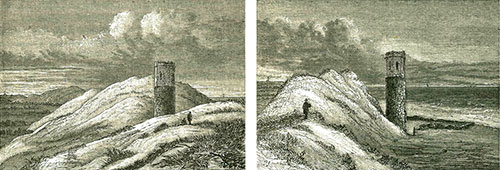
Charles Lyell used these images of the tower of the half-buried church of Eccles in later editions of Principles of Geology to show how powerful a force erosion could be, even without catastrophes. Left, the tower in 1839. Right, the tower in 1862. Image courtesy of Pocumtuck Valley Memorial Association Library.
One of the major geological questions in the late 18th and early 19th centuries centered around whether the Earth had been formed quickly, perhaps quickly enough to fit into a literal interpretation of the Book of Genesis, or if it had formed slowly. Perhaps a few major catastrophic events were all that was needed to explain the existence of high mountains and deep oceans, solid rock and eroded rubble. The two opposing schools of thought were known as "catastrophism" and "uniformitarianism".
Catastrophism dates back as a scientific idea at least to Thomas Burnet’s Sacred History of the Earth (1681), which speculated that the Earth had started out smooth and perfectly round. This perfection was destroyed in the flood described in Genesis, in which the violent, powerful action of water produced the ugly wrinkles and imperfections such as mountains, chasms, and other landforms seen on the Earth today. Burnet’s theory was in a tradition of God-centered cosmologies that started to appear toward the end of the 17th century and continued up through the 18th century. These cosmologies were not based on close observation of rocks and rock formations, but were "big picture" visions about how the world could have formed. It was these cosmologies, in fact, a combination of theology and armchair geology, that such scientists as the German Abraham Gottlob Werner (1750-1817) and the Scottish geologist James Hutton (1726-1797) were trying to do away with by studying nature straight on and deducing theories from what they could observe directly.
Catastrophism appealed to Biblical literalists, but its explanatory power derived from observational evidence that the Earth has not been in existence long enough for many landforms to have been created by subtle processes. Mountains were too big to be explained through a mechanism of gradual accretion. Deep chasms hinted at violent origins.
Fossils were perplexing: How did they get into the mountains? And where did erratics come from, those gigantic boulders made of a different type of rock than those around them? What force was strong enough to carry them so far? Catastrophists believed that one or more major events in the past had produced great distortions that pushed up the mountains and swept boulders and fossils far from where they originated, depositing them on plains or in the mountains as the energy depleted. Many 19th century people, including some geologists, believed that there was only one catastrophe, the flood described in the Book of Genesis in the Bible. Others believed that many floods or other destructive events could have occurred, not necessarily through God’s direct intervention but through natural causes.
In contrast, the uniformitarians believed that the same forces operating on the Earth today have always been active at roughly the same rate, and that over time incremental changes added up to great effect and were responsible for all geological features. Hutton developed the basic idea of uniformitarianism, but his writing style was so convoluted that his theory may not have survived had his Theory of the Earth: Proofs and Illustration not been essentially rewritten into readable form by John Playfair, a professor of natural philosophy at the University of Edinburgh.
In his Principles of Geology, published in three volumes from 1830-1833, Charles Lyell (1797-1875) took up the case for uniformitarianism: “The Earth is in a steady state; the present is the key to the past.” He used observations to document the idea that small forces could have, through increments, a large impact on the landscape. Uniformitarianism requires vast periods of time, thus allowing for the long stretches necessary for species’ evolution as envisioned by Darwin, although this was not Lyell’s purpose in Principles of Geology, published nearly three decades before Darwin’s On the Origin of Species. Indeed, although the men were close friends, it was many years before Lyell accepted Darwin’s theory of evolution.
In theory, uniformitarian processes can be governed by God as easily as catastrophes can. Hutton proposed geological time with no discoverable beginning and no end, but he still saw the creation of the Earth as evidence of the design of a benign God making a comfortable home for His creatures. Still, Hutton’s notion of an open-ended cycle of time, often cited as his greatest contribution to science, disposed of the need for catastrophic explanations, and he did not base his reasoning in any fundamental sense on catastrophism. He would today be called an actualist; that is, he believed in uniform forces but also allowed for the possibility that some processes, for example, volcanism, had acted with greater power or frequency in the past. Lyell excluded catastrophes altogether, believing that it was not necessary to call upon them at all to explain geological phenomena.
As the ideas were worked out, most geologists came to accept a mix of catastrophic and uniform forces in the creation of the Earth, and nearly all accepted that the Earth was formed millions of years before plants, animals, and people began to appear.